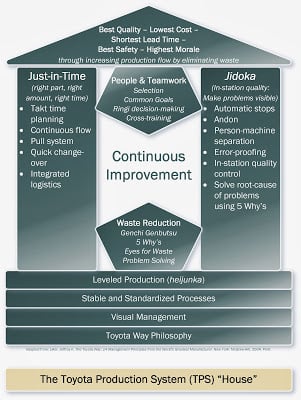In our work with many small to mid-sized businesses (SMBs), we find they are frequently struggling to leap the chasm from entrepreneurial to enterprise. Their stories are frequently very similar: once a thriving, rapidly-growing, and highly-profitable entrepreneurial firm, they seem to have stagnated somewhere along the way.
Often, while the firms’ revenues are still growing, profits are flat—or, sometimes, even declining. Once the high profits garnered from innovation flowed into the firm’s coffers with ease. Now, squeezed between a flat economy, hungry competition and steadily growing overhead, they seem unable to break out of the doldrums and return to the steady growth and profits of years gone by.

The Entrepreneur’s Vision and Strategy
What makes an entrepreneur successful? What makes the entrepreneurial business leap to life and thrive?
The answer to this question is almost always the same, even though the actual products or services offered by the myriad of entrepreneurial startups may vary dramatically.
The answer is: the entrepreneur begins with meeting the needs of a distinct market (i.e., group of buyers or customers) in a way that is of particularly high value in the eye of the consumers in that market.
In the beginning, typically, there is not much competition—there are not many other firms offering a similar product or service, or meeting the same need in some other way. If the market is quite profitable and large enough that it is not easily saturated, however, competition will arise.
Nevertheless, the early success and profitability of the entrepreneurial firm is generally driven by three factors:
- A clear vision of the particular market’s need and how to meet it
- Clarity in strategy and tactics, imparted by the entrepreneur, for delivery of the products/services
- Lower operating expenses than competitors
In the early days of the firm’s growth, it is pretty easy for the entrepreneurial leadership to communicate the vision and strategy that has created success up to that point.
However, there generally comes a time in the growth and evolution of such a firm when other factors start to create pressures that must be dealt with including (but not limited to):
- Competition
- Changes in the market
- Changes in the economy at-large
- Growing demands of overhead to support the growth
As these pressures mount, it is often difficult for the entrepreneurial executives to stay true to those critical elements that led to their early success and profits.
Focus Lost
The entrepreneurial executive, once acutely focused on a vision and strategy that was bringing success day-after-day, begins to have other cares pressing in on him or her. They are no longer focused on a singular strategy with support tactics. Instead, they find they are constantly distracted by the need to beating their competition, acceding to changes in the marketplace, dealing with economic recession, and managing the demand of more and more employees now required to keep the firm delivering products and services.
It almost seems to the entrepreneurial executive that these other matters have taken on a life of their own. Demands from human resources, payroll, accounts payable, collections, research and development and, perhaps, a dozen other departments all seem to be very loosely connected, if they are connected at all.
Pushing one lever or pulling another no longer seem to have the same affect on revenues or profits as they used to have. It becomes virtually impossible to tell if changing factor X in marketing is going to provide the desired effect on the bottom line; or if changing factor Y in production is going to actually improve the rate at which shipments get out the door complete and on-time.
At this point, the SMB trying to make the transition from entrepreneurial to enterprise frequently falls into what we call oscillation. A company caught in oscillation might find that managers and executives are focused on cost-cutting and product pricing for one period of time; then, when they see potentially negative affects from this policy focus, they switch to policies that are focused on higher quality and improving levels of customer service. However, after a while, when cost rise too high and profits become unsatisfactory, the management team swings back to cost-cutting and fighting the competition by lowering prices.
Companies—and there are lots of them—caught in oscillation between two or three different approaches to management generally are suffering in other ways, as well. For example, their employee turnover rates will tend to be higher due to the level of frustration the employees have over the constant changes in policies, procedures and metrics.

Constancy of Purpose
W. Edwards Deming promoted what he called “constancy of purpose” as being, perhaps, the critical factor in the long-term success of an enterprise.
Toyota executives speak frequently of the “foundation” of the Toyota “house” as being a philosophy that takes the long view—basing management decisions on long-term thinking, even at the expense of short-term financial goals. They refer to this as the “Toyota Way Philosophy” and adherence to it has led this firm to become a world-class manufacturer with profits generally excelling its competitors.
Focus Regained
When we work with companies and their management team, we help them regain their focus on what matters. Interestingly, this newly restored focus is on the same things, generally speaking, which the founder(s) of the firm were focus some years earlier: innovation in finding ways to meet the unique needs of a specific market (market segmentation) through offers that are too good to refuse and offers unlikely to be matched by their competition (because the competition hasn’t discovered the secret that makes the offer profitable).
We help the management team apply the Thinking Processes so that they actually invent their own solution.
This is the first step toward getting such struggling companies back on track with clarity of vision, support strategies and tactics, and (believe it or not) control over the growth of operating expenses.
Stay tuned for Part 2 on “Rediscovering Strategy.”
In the meantime, feel free to leave your comments here or contact us directly, if you prefer.



